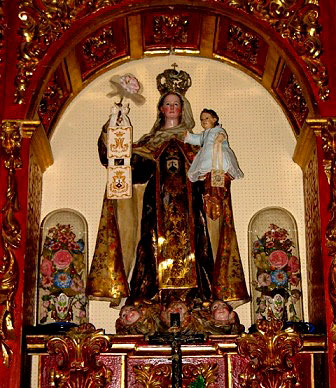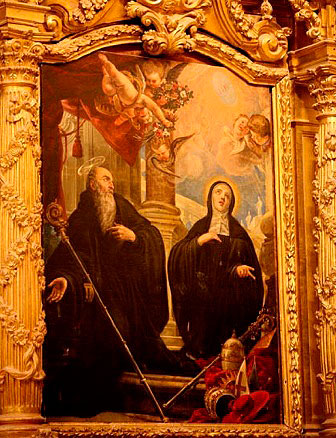BRINGING HERITAGE CLOSER. CORELLA
25 August 2010
The hidden Corella. Behind the lattices of the city's enclosures
D. Ricardo Fernández Gracia. Chair of Navarrese Heritage and Art
The case of Corella with regard to the manifestations of Baroque art and the devotions that came from the religious orders is no different in any way from what was happening in the rest of Spain. If anything, the phenomenon was much more important as there were no less than four convents in the town, which placed it at the top in terms of the ratio of convents to inhabitants in Navarre at that time.
The male and female branches of the Discalced Carmelites, the Mercedarians and the Benedictines spread devotions in their churches and outside them - throughout the urban spectrum - which brought with them, through the development of iconographies, visible in images, paintings and pieces of sumptuary art, still present in temples, private collections and other institutions in the town. In addition to the visual aspect, countless religious practices such as novenas, sermons, Salves, siestas and festivals have been deeply rooted in families, people and institutions, and to this day we can trace several devotional practices that originated at certain times and many other religious men and women who lived in or passed through Corella.
Particular interest was shown by those religious orders in spreading the invocations of the Virgin that were proper to them, in plenary session of the Executive Council period of the Catholic Reformation, after the Council of Trent. The sons of Santa Teresa promoted the cult and iconography of the Virgin of Carmen, from the excellent sculptural examples of Carmen and Araceli, to the embroidered and engraved scapulars, and an endless number of canvases and chapels or shop windows that faithfully reproduce altars with all kinds of ornaments subject . The Mercedarians did the same with the Virgen de la Merced and the Benedictines with the Virgen del Socorro, so popular in the monasteries of the sons and daughters of Saint Benedict. As far as the Virgen del Carmen and the Virgen de la Merced were concerned, the Bull of Urban VIII of 1642 prohibiting Mary to be dressed in the habits of religious orders was of no use.
A local Marian devotion, the Virgin of Araceli, was associated with the Discalced Carmelites from the very moment of its foundation in 1722, and the nuns became "perpetual waitresses" of the image, watching over its adornment and worship. Engraved engravings, lithographs, photographs, small altars in the usual shop windows, scapulars, novenas, music and oratory pieces give a good account of the whole festive world organised around that Marian simulacrum.
Other outstanding iconographies in the city derived from the devotional impulse given by the aforementioned religious institutes to their founders and foundresses. Thus, the Carmelites spread the cult and images of Saint Teresa, Saint John of the Cross and the mythical Saint Elias, the Mercedarians did the same with Saint Peter Nolasco, Saint Raymond Nonnatus and Saint Mary of Cervelló and the Benedictines with Saint Benedict, Saint Scholastica, Saint Placido and Saint Gertrude. Top quality canvases imported from the Court, where the best art was consumed, from the brushes of Pedro Orrente, Claudio Coello, José Ximénez Donoso and Espinosa de los Monteros are a perfect exponent of the artistic tastes and levels reached in the city throughout the 17th and 18th centuries.
All these images, those of great artists, those of others of lesser status and those of a popular nature, took on a special dimension at a time when the majority of the social masses could not read and the means of disseminating culture necessarily followed the paths of plastic expression and oratory.
Together with the artistic pieces of figurative art, we cannot fail to mention a very important repertoire of musical scores - hymns, gozos or arias - dedicated to the exaltatio gaudium on the festivities of all those models of sanctity which, sometimes with skill, the religious established in Corella during those centuries of the Baroque which, as is well known, tried to captivate through the senses, always weaker than the intellect.
The whole collection of works of cultural interest that the convents of the city kept or kept, part of which is still preserved and will be exhibited on another occasion, is a separate chapter.

Virgin of Carmen. Convent of Araceli de Corella, f. XVII

Canvas by José Ximénez Donoso with St. Benedict and St. Scholastica. Former convent of the Encarnación de Corella

Vision of Saint Teresa, by Pedro de Orrente at the Convent of El Carmen in Corella
PROGRAM
Tuesday, 24th August
Milestones in the History of Corella
D. Esteban Orta Rubio. Society of Historical Studies of Navarre
Writers and publicists of Baroque Corella
Mr. Javier Itúrbide Díaz. Uned of Tudela
Corella in the culture and art of the Baroque period
D. Ricardo Fernández Gracia. Chair of Heritage and Art of Navarre
Wednesday, 25th August
The hidden Corella. Behind the lattices of the city's enclosures
D. Ricardo Fernández Gracia. Chair of Navarrese Heritage and Art
The sumptuary arts: at the service of the splendour of worship and the Liturgy
D. Ignacio Miguéliz Valcarlos. Chair of Navarrese Heritage and Art
The festive calendar
D. Francisco J. Alfaro Pérez. University of Zaragoza
visit to the church of San Miguel
visit to the tunnels
Thursday, 26th August
A look at architecture and the arts in Corella in the 19th and 20th centuries
José Javier Azanza López. Chair of Navarrese Heritage and Art
The image of the Rosary and Saint Michael in the arts
Ms. Mª Gabriela Torres Olleta. GRISO. University of Navarra
Corella, conventual and palatial city: visit guided tour
Ms. Pilar Andueza Unanua. Chair of Navarrese Heritage and Art
Closing

